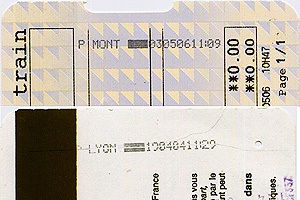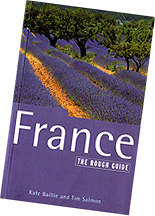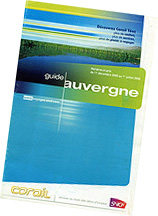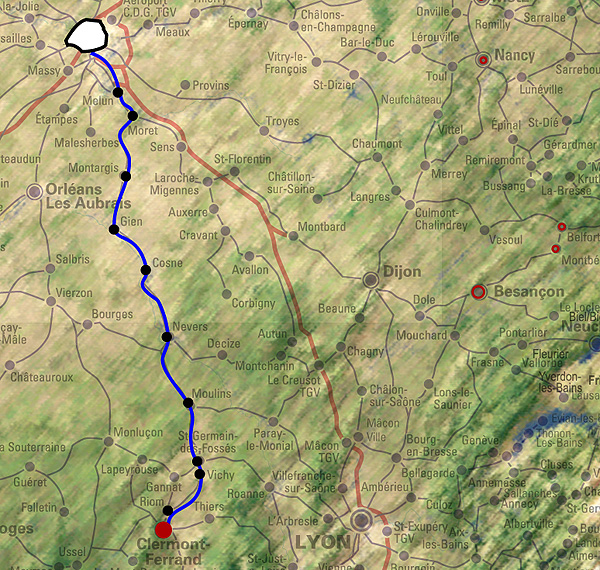Ticket Talk
|
|
Printed across the top of every SNCF train ticket (billet, in French, pronounced “bee-yay”) is the phrase “BILLET à composter avant l'accès au train.” I recall being a bit confused by this the first times I encountered it, as in English “composting” is essentially the recycling of plant matter, but in French it means “date-stamping” (or punching). This is essential, as your ticket must indicate that you departed the station your ticket says you were travelling from; train personnel pass through the railway cars to check everybody’s ticket for this or to see otherwise validated passes. You get your ticket stamped at any of the little “composting” machines found at the front end of train platforms or around the waiting hall: simply insert one end of your ticket in the slot on the machine, and after its little dot-matrix print mechanism makes a little “brrzrzrp!” noise you withdraw your ticket, and you’re free to get on your train anytime. It doesn’t matter if your ticket is face-up or face-down, as you can see:

A Eurail pass is good for unlimited travel on national rail networks for countries of your choice over a period of time you specify when purchasing the ticket. The arrangement I chose was a “Selectpass” to be valid for nine days of travel within a two-month timeframe, starting from the day I had the ticket validated in person at a train station. Therefore my pass, which is the same size as a ticket but looks quite different and contains a good deal of information (country of residence, passport number, dates of travel, price paid, etc.), indicates that it was validated at the gare du Nord on the 19th of April 2006 and therefore was good until the 18th of June, the dates being hand-written by the guy at the ticket window and the validation itself being stamped.
|
3. Spokane, France?
Clermont-Ferrand (“CLEHR-moh[n]-feh-hrRAHN,” pop. ~140,000), in the center of France, is not a big tourist magnet, at least not by comparison to the many tourist magnets France can boast of having. What little I’d found to read about it (and I’d never heard anything because nobody I know who knows France knows Clermont-Ferrand) indicated that it was a regionally important city with almost no attractive qualities—hardly the stuff of multiple stars in Michelin guides, despite the fact that this was where the Michelin tire industry originated.

On the subject of guides, I should mention at this point that I actually travelled with two guides on this trip, uncharacteristically—the Rough Guide to France and the Rough Guide to Switzerland (the latter bought a day or two before my trip and not cracked until I was in Switzerland). My interests and my way of travel rarely coincide with advice given in guidebooks, even these, but one aspect of previous travels that I’d tried and found unsatisfactory was the approach of going somewhere without knowing anything about it in advance and learning what I could while there: too often I’ve later learned some basic info about the place that would have given it much better context for appreciation at the time. Still, these books were brought to be used as on-the-fly reference more than as guides. The results were mixed, but I’ll address that at the end of my tale.
I spent the first half of the train trip from Paris to Clermont-Ferrand just noticing the southeast suburbs of Paris and the cities beyond them as the countryside mostly took over and the rich abundant greenness of springtime France rolled everywhere I looked. Lilacs were budding, fields were bright and lush, and every little town along the rail line had some evident character (even if it was in the city’s backside, seen only by the trains…some towns address that issue, but most ignore it). They do all tend to look the same after awhile, however, especially as your mind wanders in the anticipation of travels to come.
The landscape on the northeast approach to Clermont-Ferrand was almost a letdown. This is what comes of having seen alps and then getting too literal about the name “Massif Central” which is applied to the region (a vast plateau, heavy on the volcanic geology). The land does swell a bit there and achieve some sense of having topography, but it wasn’t exactly Mount Rainier or even notably mountainous from that direction. The city itself is pleasantly arrayed over just enough variety of hills to encourage localities, and of course it has that nice dark cathedral on its main butte, but it’s not until you’re in town that you get to see much of the more significant slopes to the west which rather overshadow Clermont-Ferrand by belated comparison. And all this comes at what is the one major stop on this route through seemingly endless farming country, which confirmed my pre-trip impression of Clermont-Ferrand as being to France as Spokane is to Washington State in the U.S.: not in itself a bad city but hardly a destination of great appeal when compared to many cities around Puget Sound for example…even Yakima has more of a draw now that the wine industry’s grown sufficiently.

All that was going through my head as the train arrived in Clermont-Ferrand that Wednesday, and then I turned to the immediate challenge of finding my hotel. I’d booked two nights at the city’s Étap-Hôtel while still in Seattle, giving myself (as I said earlier) a starting point for my journey, a place to catch my breath after the first great leap and to get my bearings.
Oh, the irony, in retrospect….
I’m laughing a little now as I write about it, but at the time what happened next was a whole lot of No Fun At All. I got off the train and immediately set about studying the local transit maps posted at the station, trying to determine the city’s basic layout as well as the location of the neighborhood or suburb named Aubière where the hotel was. Determining eventually that it was quite a way south, maybe southeast, of town, I boarded the first bus for Line #2 (which served that area) that came along. I’m no fool: after letting the other passengers get on/off, I approached the driver to ask which stop I should request for the hotel’s address (avenue Lavoisier). I was not particularly prepared for his look of complete bafflement, but I patiently waited for him to muse over how it might be in the new extension of Aubière as opposed to the older town. Finally he concluded that what I wanted was a #3 bus, which might get me near there. But he wasn’t sure.
Off the bus with polite thanks to the driver, onto a #3 passing very soon afterward where he’d let me off, I then spent several minutes studying the #3’s route map to see what names and things to watch for that would get me to a zone somewhere east of where the #2’s driver’s bus said the new town area was. (I think the #3 driver must have been busy with other passengers or nasty traffic in this case, because for some reason I didn’t approach him about the matter.) After 20 minutes or so I saw that we were heading on the eastern side of a long loop southeast of Clermont-Ferrand, that the bus would probably be at the south end for a while, and that the place I presumably wanted to get to was roughly on the western side of the loop from where the bus was at the moment, and I pulled the cord to ring the “request stop” bell and got off.
Bags and all, I then found myself wandering around what seemed to be an affluent suburb which felt like it was the residences of owners of nearby vineyards…in search of streets, first of all, to traverse these long rows of fenced houses and yards to get nearer the river (the “river” being actually just a stream, the Grande Rase de Sarliève, somewhere down the gentle slope to the west), where maybe I might see an indication of anything relevant to my hotel’s location. All I knew from the hotel chain’s website and booklet of locations was that it was 1. near some new major exhibition hall and 2. close to the “CinéDome” cineplex (a fact which, in hindsight, was what I should have told either bus driver, but that wasn’t obvious at the time, and an avenue name seemed to be sufficient).
Well, “near” is a relative term, as I’d bet we’ve all learned to our discomfort at some time or other. In this case it meant “within a mile or two” of the exhibition hall, but it didn’t convey any suggestion that only highways actually linked the two places (and only north-south ones at that). Which is how I spent the next couple of hours staggering around the southeastern outskirts of Clermont-Ferrand, my bags dragging me down in the ever-increasing heat, along highways and across plowed-up edges of fields and road-construction areas, sweating and cursing and wondering if this was going to be another defeat-after-defeat trip like the last one I’d had in France….
To make the story mercifully shorter than the walk was, now that you’ve got the image, I’ll just say that I did get to the hotel shortly before nightfall; its location is the industrial zone of Aubière, more exactly, approximately 3.5 miles from the middle of town as the crow flies, and it is in fact quite close to the CinéDome, as is everything on avenue Lavoisier because the avenue encircles it and is the home of various budget-ish hotels and French chain-restaurants such as Hippopotamus and RestauMarché. Nearly everything else in the region seemed to be home-improvement stores and outlet shops. The #13 bus actually does come within a couple of blocks of the hotel but only once or twice a day and not on weekends; the #2 is the next-closest one (well, I didn’t get to compare the #3’s nearest stop for walking distance, but either way it had to have been around 15-20 minutes), which naturally irked me to discover after all that, but even so it stopped running around 19h30.
All of this meant that once I got to the hotel I was pretty much stuck there. I had no idea how far from the town “proper” I was, as I’d lost most sense of distance in the wandering and busing, and as I’d been in transit from my apartment in Seattle for 29 hours as of my arrival at the hotel (yes, this is still just the first day!) I was in no condition to explore that question. I resigned myself to a chain-restaurant dinner followed by absolutely nothing to do but watch the news and sleep.
I noticed as I was about to go in search of food (after a shower and a brief cat-nap) that when I took off my shoes and stood in just socks or bare feet it felt like the ground was shaking…which was hardly surprising, in retrospect, as I later determined that I’d covered around five miles since getting off the bus. And that upon catching my reflection in a mirror I had apparently been baked shrimp-pink by all that striding around in the sunny, roasting afternoon.
Dinner, at Les 3 Brasseurs, was pretty forgettable. I had an éstouffade du boeuf—decently tasty stewed beef with a gutless sauce served on lifeless and soulless fettucine—with one slightly-sweet but full-bodied amber beer (I’d asked for a second one eventually but my distracted/disinterested waitress delivered it to the guy at the next table instead…he’d ordered the same thing, and clearly we were all tired enough that it wasn’t deemed worth addressing by any of us).
The next day, a Thursday, was spent wandering around Clermont-Ferrand itself and discovering that the place was actually somewhat lively if preoccupied with business. The city may still be exploring its options for economic growth in the aftermath of the decline of its old industries (such as Michelin tires), but it doesn’t have a feeling of having lost ground so much as having paused to think before striding in a slightly different direction, and that stride felt like it was well underway. In that I was surprised: it’s described so disparagingly that I had expected something grimier and more bitter, like maybe Manchester (England England). But it was, in reality, not a bad place.
After busing from New Siberia to the city center, watching carefully the whole time to see both what the character of the city’s approach and traversed neighborhoods was as well as how far apart the two ends of the journey actually were, I visited four of the city’s main churches (it’s a thing of mine, what can I say?). These included the big dark Notre Dame de l’Assomption cathedral, which unfortunately I visited first and then forgot about for the most part except for its interesting (if slightly less impressive in reality than in theory) blind-friendly model of the cathedral with its building materials tactilely distinguished with different kinds of wood. After that, and an impressively huge and quite tasty and novel crêpe at Crêp’uscule (on the rue Pascal), I visited three other churches—Notre Dame du Port, St Eutrope, and St Pierre Les Minimes—and got a good sense of the central area’s sense of history and continuity.
Clermont-Ferrand has a nice clean feel overall, clean but not sanitized or artificial, and its center has at the moment both a bit of extensive road-improvement at the edges (of the kind that simply replaces something already functionally present rather than being a neighborhood-destroyer, at least to my eye, although its gap between neighborhoods and center is certainly there) and a somewhat tentative appreciation of the tourism industry and how to accommodate it unobtrusively. By the latter I mean that there are some wayfinding elements for tourists—signage around the cathedral, for example—but they’re discreet and focused more on the town as a whole and the history and context of what’s being noted, rather than on individual “sights to see.” There’s a bit of potential being tested there, although it also has that ghastly big lifeless place de Jaude which on a hot day is basically a cookie sheet (as opposed to what the Rough Guide to France refers to as “the hideously modernized place St-Pierre,” which at least offered some shade although you wouldn’t want to sit and look at the place for long).
Which brings me back to the weather, but only briefly: “unseasonably warm,” a phrase I’ve come to both expect and loathe in my travels (actually I’m learning to pack for it as a given, so there’s a positive spin after all). But I found that the shady sides of all tall buildings served me well on my walk, and that in turn led me past an inelegant public park where ten or eleven games of boules were being played by a mostly-50s+ constituency, and I stopped to watch for around half an hour. I’m a boules player myself, thanks to my then-coworker Kevin Carl who got the usually unresponsive and inert Seattle Parks Department to put in a couple of (temporary) boules/bocce/pétanque courts in Occidental Square before they ripped the place to shit this year (but that’s another story), and when I saw these games in play I simply had to stop—both to enjoy the scene and to assess the players’ relative skill and technique levels in comparison to that of myself and my occasional opponents. This is how I first discovered that some players carry handy magnets-on-strings for picking up their boules at the end of a round without having to bend over or strain their backs. I’ll be an old man indeed if I ever start using one, but it was an amusing novelty to encounter.
Informed of the city’s actual geography by my bus ride into town that morning, I decided to verify it and imprint it in my memory by walking back to my hotel’s “industrial zone” rather than taking any bus. (I had a short memory as regards my feet, apparently, which I’d walked halfway to pulp only the day before, but my feet remembered it all pretty quickly.) But first I quickly checked my email at a vaguely identified business of Middle-Eastern nature near the train station; I gathered it was a café but didn’t stay long enough to explore it at all—it was the only place I saw in town that advertised web access, and the computers for this were in a small back room up two or three flights of stairs…good thing I’m not timid or nervous.
Over the city’s southeastern ridge, and through university grounds and a suburb or two rich with lilacs and a sense of unluxurious affluence, I walked with unhurried pace and easily satisfied curiosity, and before long I was within sight of the bus stop where I’d started that morning. At a nearby gas station I bought some water and juice to drink as well as a map of the city and its environs…too little too late? Not at all; it would have been nice to have the latter in advance, but as things went I did get an adventure out of the situation as well as learning about the city.
The hotel arrangement was untenable, and I’d not seen anything in Clermont-Ferrand to compel me to shift digs and stick around, so I considered my options for other places in the region and concluded that Le Puy sounded strange enough as described in the Rough Guide (“both landscape and architecture are totally theatrical” … “the landscape erupts in a chaos of volcanic acne”) to at least see from the train. I had a decent steak-with-roquefort-sauce dinner at the Hippopotamus near the hotel, reluctantly, after walking west to the old town of Aubière (“oh-b’YAIR,” pop. 10,000, by the way) and discovering that it pretty much shuts down around 20h00, and settled into a second dull night in the hotel, reading myself to sleep.

Text © 2006 Mark Ellis Walker, except as noted



